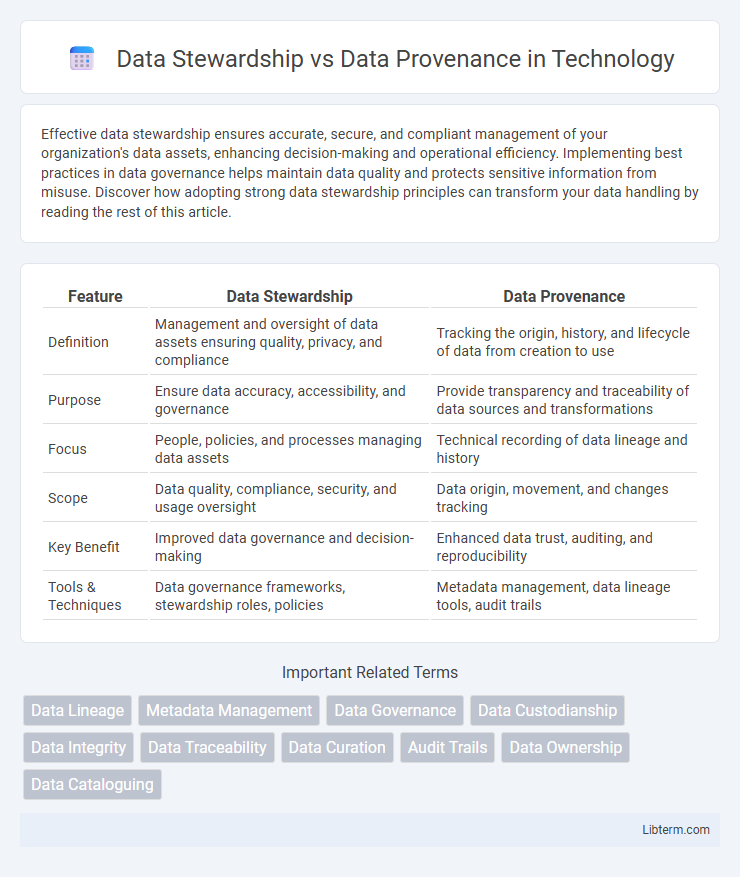Effective data stewardship ensures accurate, secure, and compliant management of your organization's data assets, enhancing decision-making and operational efficiency. Implementing best practices in data governance helps maintain data quality and protects sensitive information from misuse. Discover how adopting strong data stewardship principles can transform your data handling by reading the rest of this article.
Table of Comparison
| Feature | Data Stewardship | Data Provenance |
|---|---|---|
| Definition | Management and oversight of data assets ensuring quality, privacy, and compliance | Tracking the origin, history, and lifecycle of data from creation to use |
| Purpose | Ensure data accuracy, accessibility, and governance | Provide transparency and traceability of data sources and transformations |
| Focus | People, policies, and processes managing data assets | Technical recording of data lineage and history |
| Scope | Data quality, compliance, security, and usage oversight | Data origin, movement, and changes tracking |
| Key Benefit | Improved data governance and decision-making | Enhanced data trust, auditing, and reproducibility |
| Tools & Techniques | Data governance frameworks, stewardship roles, policies | Metadata management, data lineage tools, audit trails |
Understanding Data Stewardship
Data stewardship involves the responsibility for managing data quality, integrity, and security throughout its lifecycle, ensuring compliance with organizational policies and regulatory standards. It encompasses activities such as data governance, access control, and metadata management to support accurate and reliable data use. Understanding data stewardship is crucial for establishing accountability frameworks that protect data assets and enhance decision-making processes.
Defining Data Provenance
Data provenance refers to the detailed documentation of the origin, history, and lifecycle of data, including its sources, transformations, and ownership changes, ensuring transparency and trust in data quality. It plays a critical role in verifying data accuracy and enabling reproducibility in analytics and decision-making processes. Unlike data stewardship, which focuses on data governance and management responsibilities, data provenance specifically tracks the data's lineage and traceability across systems.
Key Differences Between Data Stewardship and Data Provenance
Data stewardship involves the management and oversight of data assets, ensuring data quality, privacy, and compliance throughout its lifecycle, while data provenance focuses on the origin and history of data, tracking its transformations and lineage. Key differences include that data stewardship emphasizes governance policies and accountability for data accuracy and security, whereas data provenance provides a detailed audit trail of data sources, changes, and processing activities. Effective data management integrates both by combining stewardship responsibilities with provenance tracking to maintain trustworthy and traceable data.
Core Responsibilities of Data Stewards
Data stewards are primarily responsible for ensuring data quality, managing data access, and enforcing data governance policies, which includes maintaining data accuracy, completeness, and consistency across the organization. They collaborate with stakeholders to define data standards and handle data lifecycle management, playing a critical role in protecting sensitive information and ensuring compliance with regulatory requirements. In contrast, data provenance focuses on tracking the origin, lineage, and transformations of data, providing transparency and auditability rather than direct data management.
The Role of Data Provenance in Data Management
Data provenance plays a critical role in data management by tracking the origin, lineage, and transformations of data throughout its lifecycle, ensuring transparency and accountability. It enables organizations to validate data authenticity, improve data quality, and support compliance with regulatory standards such as GDPR and HIPAA. By maintaining detailed provenance records, businesses enhance trust in their data assets and streamline auditing, analysis, and decision-making processes.
Benefits of Effective Data Stewardship
Effective data stewardship ensures data accuracy, consistency, and security, which enhances organizational decision-making and regulatory compliance. It establishes clear roles and responsibilities for managing data assets, reducing risks associated with data misuse or loss. Data stewardship complements data provenance by maintaining trusted data throughout its lifecycle, enabling reliable tracking of data origins and transformations.
Importance of Data Provenance in Ensuring Data Integrity
Data provenance plays a critical role in ensuring data integrity by providing detailed records of data origin, transformations, and handling processes. It enables organizations to verify the authenticity and accuracy of data throughout its lifecycle, reducing risks of errors or tampering. Unlike data stewardship, which focuses on governance and policy enforcement, data provenance offers transparency and traceability essential for compliance and trustworthy analytics.
Data Stewardship Best Practices
Data stewardship best practices emphasize establishing clear ownership and accountability for data assets, ensuring data quality, consistency, and compliance with regulatory standards. Effective data stewardship involves implementing robust data governance frameworks, regular audits, and continuous training to maintain data integrity and security across the organization. Leveraging metadata management and standardized documentation enhances transparency and facilitates seamless data sharing and collaboration.
Enhancing Data Traceability with Data Provenance
Data provenance plays a critical role in enhancing data traceability by documenting the origin, movement, and transformations of data throughout its lifecycle. Unlike data stewardship, which focuses on the management and accountability of data quality, provenance provides a detailed audit trail that enables users to verify data authenticity and lineage. Integrating data provenance with stewardship practices significantly improves transparency and trust in data-driven decision-making processes.
Integrating Data Stewardship and Data Provenance for Optimal Data Governance
Integrating data stewardship and data provenance enhances data governance by ensuring both accountability and traceability across data lifecycles. Data stewardship involves assigning responsibilities for data quality, security, and compliance, while data provenance tracks data origins and transformations, enabling transparency and trust. Combining these elements supports comprehensive risk management, regulatory adherence, and improved decision-making within organizations.
Data Stewardship Infographic

 libterm.com
libterm.com